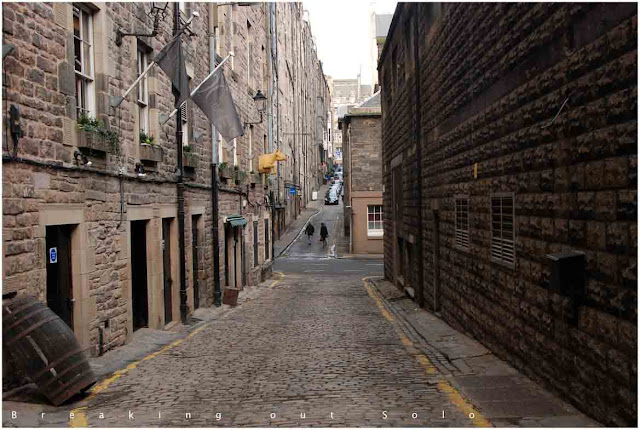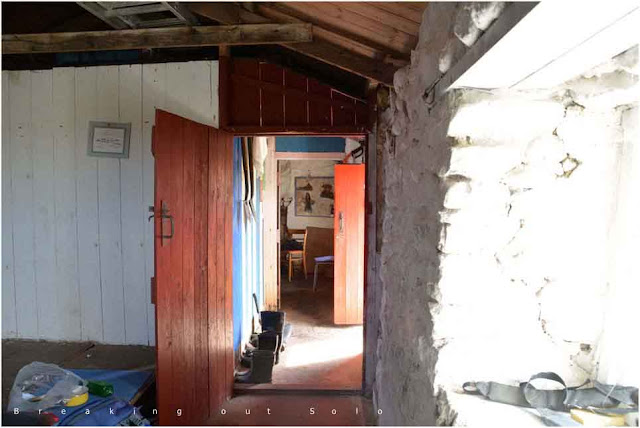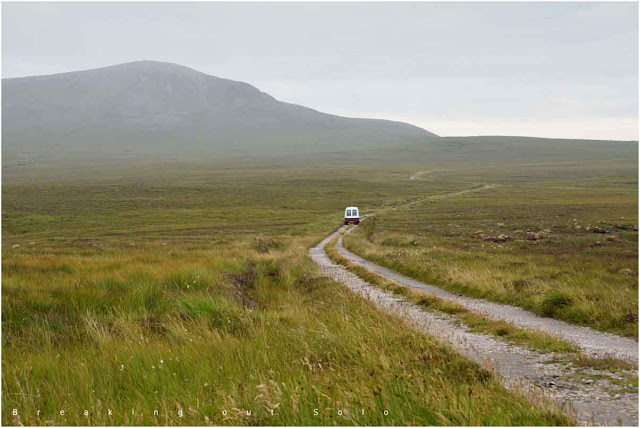 |
| Morning in Edinburgh, the first light washing the castle in its golden glow. |
Edinburgh, the capital city of Scotland.
Alongside being the political capital, Edinburgh also counts as the historical and cultural capital of Scotland on the visitor's map. For over a decade I have been lucky to call the place my home. Though I did leave the country intermittently, but was never away for long. And on every return, as the flight touched down, I felt the familiar warmth in my heart, of returning home.
Surprisingly for a capital city, the place emits a 'small town' feel like no other. Probably my reason of falling in love with it even more. The city is built on seven hills, similar to Rome, and at its very heart is the Castle rock, a rocky crag, an ancient volcanic plug. Perched on its top, dominating the city skyline is one of the world's most photographed castles.
Edinburgh castle has been a medieval royal residence and fortress and in its history of over a thousand years, one of the most attacked places in the world too.
 |
| Edinburgh castle with the dark spire of the Gothic Scott monument |
The castle esplanade stands high above the city providing a spectacular viewpoint, highly enhanced on a clear, sunny day. The city stretches around it as far as the eyes can see.
The south-west horizon is taken up by the Pentland hills rising beyond the city limits and the big hump of Arthur's seat and Salisbury crags is to the northeast. Below, and surrounding the castle, is the Old town, the medieval city that still lives on alongside the modern world. The city has been built on different levels, which is clearly visible from this elevated viewpoint. You can see the impressive building of George Heriot's school straight ahead as the different levels of old buildings gradually melt into the much newer Edinburgh. On a Saturday morning you might even catch a glimpse of the blue and white tents of the Farmer's market on the Castle Terrace. A freshly fried buffalo burger from here is a good way to start a morning walk.
Walk around the esplanade and though the view to the east is restricted, the distinct red and white cluster of buildings of Ramsay Gardens with their sloping roofs paint a pretty picture. Behind these would be Calton hill topped by the observatory, Nelson's monument and the distinct neo-classical structure of the National monument. This was designed after the Parthenon of Athens but by many, is considered a folly, a misfit. Having run out of funds, the structure was never finished.
Beyond Calton hill, from the mix of old and new structures of the city, church spires reach out to the sky till the gaze meets the blue waters of the Firth of Forth in the north.
Still looking north but much closer, a busy city life unfolds across the gardens in Princes street. Located at the edge of the eighteenth century New town, the buildings on Princes street are from different eras. Some are ornate, some stark, standing side by side in strict discipline. The pavement below is overrun by shoppers, visitors and the daily bread-earners as double-decker buses, and now the trams, ply the street beside them. And finally you turn around to the castle on the west, a grand entrance across the moat.
The castle is the most popular tourist site in Scotland and is definitely worth a visit. If history doesn't interest you, then definitely visit for the views.
Every year during August, the festival month, the castle esplanade explodes in a medley of lights, colours, music and the harmonious rhythm of marching feet. This is where the Edinburgh Military Tattoo takes place almost on all nights of the festival against the spectacular backdrop of the castle.
 |
| Military Tattoo on the castle esplanade |
 |
| West Bow |
 |
| Victoria Street |
The Old town has an eclectic mix of traditional and modern pubs, restaurants and fast food joints serving food from around the globe, quaint little cafes brushing shoulders with international ones, souvenir shops and tattoo parlours dot the Old town. The place is always busy with tourists and students alike as this is where the old University of Edinburgh is located too.
From the castle esplanade the Royal Mile slopes downwards to the east, all the way to the Palace of Holyrood House. Comprising of four streets Castlehill, High Street, Lawnmarket and Canongate, this is the heart of Old town. As the name suggests, the Royal Mile stretches for a 'Scottish mile' joining the two royal residences. The palace is the queen's official residence in Scotland where she still holds her summer tea parties. Beside the palace is the new Scottish Parliament, a modern structure which has been the cause of controversies, not only for what happens within its walls.
Walking the Royal Mile is a must when visiting Edinburgh. Its cobbled stoned streets lined by old tenement buildings standing cosily against each other, only interrupted by its many closes, passages made between buildings which lead to lower streets, courtyards and gardens. This is how the different levels of Old town are connected - closes, steep stairs and narrow wynds. Be adventurous and walk down them to find where they lead to. Some of these places are half a century old and you can imagine they wouldn't be as perfectly cobbled stoned as they are now. They would have been used by the common people in their daily commute to the various markets as their names suggest.
 |
| Old Fishmarket Close - Leading to Cowgate. |
 |
| Advocate close - leading down to Cockburn street. |
The old buildings on the Royal Mile now house museums, souvenir shops, pubs and restaurants. As your travel brochure will tell, many significant architectural structures and important buildings line the Royal Mile, each of which are worth a visit. But if you can do only one, make it the St Giles' Cathedral, an important place of worship of the Church of Scotland. Entry is free and you are welcome to make a small donation. The interiors are no doubt impressive but visit the Thistle chapel and you will definitely be awestruck by its extraordinary wood carvings.
 |
| St Giles Cathedral entrance |
 |
| A quiet Royal Mile and St Gile's cathedral on a winter evening |
Exiting the cathedral, walk around the courtyard and see if you can spot the Heart of Midlothian. Behind St Giles is the old Parliament building which you can visit as well. Walk down, past Cockburn street, which deserves a visit too, and you reach the North and South Bridges. In the corner lie the Tron kirk, which hosts a Scottish food and craft market inside.
The bridges connect the Royal Mile in Old town with Princes street in the New town. Below the South Bridge, hidden away in its impressive arches, are the old vaults. These were built during the late eighteenth century to house shops and taverns. However the place wasn't weatherproof and soon became uninhabitable, to be taken over by the many dark characters who hounded the city. The vaults were blocked up for safety reasons and were only discovered as late as 1985. These can now be visited through tour companies.
Cross the bridges and continue your walk downhill, walking past the fifteenth century John Knox house standing out from its surrounding buildings with its striking exteriors, the Canongate kirkyard and the Old Tolbooth tavern. Keep an eye for the various wellheads you will find dotted around the Royal Mile, the only source of water for the common people during the medieval times.
Watching the old town rise all around you as you walk, it is very difficult to stick to your planned route and to not wander. Travel brochures lists down the places to visit and the main sights to see. But they do not prepare you for the impact when you actually walk here. Every street you pass invites you with its intrigue and you will definitely miss out on seeing the real Edinburgh if you do not follow your instincts. So drop your plans and head where your heart wants, speak to the locals and you will definitely see the Edinburgh that does not appear in the travel brochures.
 |
| Niddrie streets through Cowgate leading to the Royal Mile |
 |
| Walking down the Royal Mile at Old Tolbooth Tavern |
Walking the Royal Mile is like walking through history, tinted with the colours of modern day tourism. The reason I find, that the best time for a leisurely walk is on a late Sunday afternoon, especially during the short winter days. In the dark and cold, as the last few hours remain of the weekend, you will barely find another soul around. At least not the ones you can see but then, there maybe some which you can't.
With its medieval world charm and the bagpipers playing in the background, it is easy to lose yourself in the romanticism of the old town. But the place holds a secret deep within, and a gory one too. Hiding from plain view, buried under the streets of Old town, lies the old city, the city of the dead.
The Great Plague of 1645 killed more than half of Edinburgh's population. The only way to escape certain death was to run, abandoning the victims. The result, hundreds of plague victims were bricked up in their homes and left to die. A new life started above them in a new city. It is believed that the spirits of the victims still live on under the streets in the haunted vaults and alleys. Ghost tour operators run regular trips in this forgotten city. Ghosts are always a top tourist draw.
 |
| Royal mile shops |
 |
| Phone booths on Royal Mile |
 |
| Greyfriar's bobby as the world moves around it |
 |
| Greyfriar's bobby |
Walking the popular historical centre during busy summer weekends can be overwhelming. However, escaping from its hustle and bustle is not too difficult either.
Nearby, to the south of the castle is the Meadows, a public park with vast green fields and tree lined paths. At the other end of the town, where the Royal Mile ends in the east, lies the gigantic open space of Holyrood park.
The Holyrood park is the result of another ancient volcanic activity, the marks clearly visible in the geology of the surrounding hills and the crags of Salisbury. The hills rise to their highest point at Arthur's seat. At 251m, this is Edinburgh's highest point and provides amazing views of the city and the Lothians. The lush green ancient volcanic landscape also has three pretty lochs of St Margaret, Dunsapie and Duddingston, home to a wide variety of birds.
 |
| The Meadows with Arthur's seat in the distance |
 |
Arthur's seat from the Meadows
|
I have spent many weekends walking the Old town, with or without a camera, finding hidden corners I have never visited before. I never knew where a close or a street will lead to, but more often than not, there was a surprise waiting.
In the Old town, there is no worry about getting lost, because only by losing your way is how you discover the true spirit of the place. But if it indeed worries you, look around and the distinctive shape of Arthur's seat towering over the city will guide you back.
 |
Holyrood park from Salisbury craig
|





































